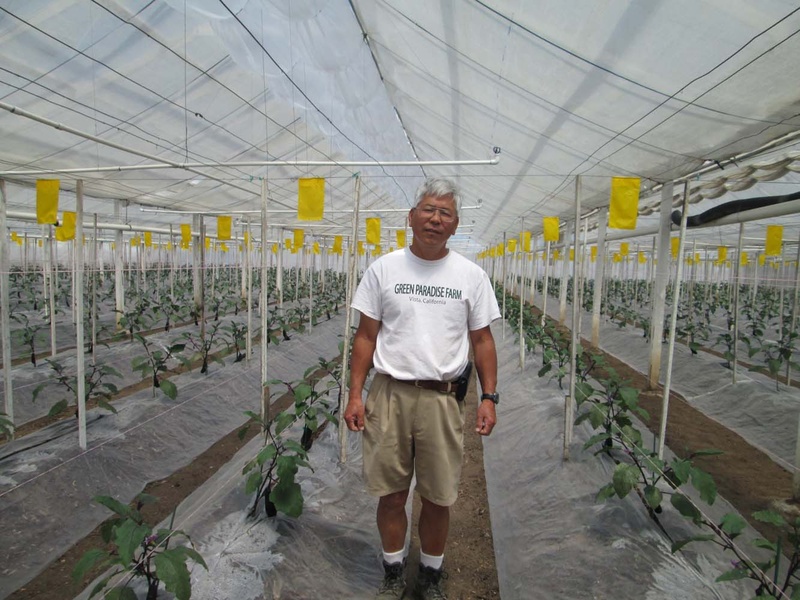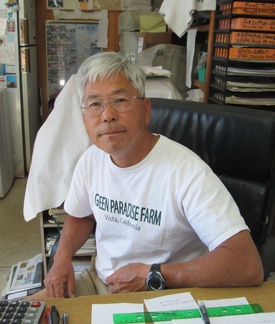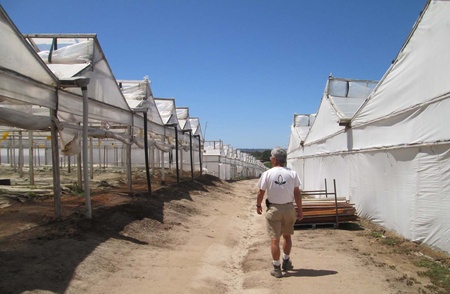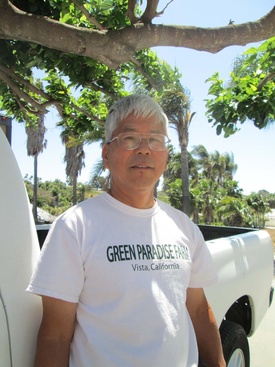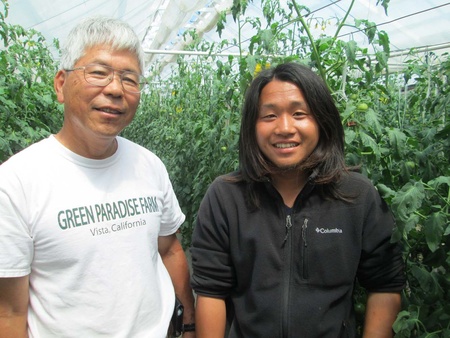In the 1970s, he went to Oregon for agricultural training.
We usually see Japanese vegetables in Japanese supermarkets and Japanese restaurants. I have never really thought about where and by whom they are grown. I had always assumed they were grown by Japanese farmers, but then an acquaintance of mine who moved from Los Angeles to the Oceanside area, halfway between San Diego and San Diego, told me that there was a Japanese person nearby who was growing a wide variety of Japanese vegetables. That person was Sadaharu Nishio, a Shinsei (first generation) from Fukuoka City, Fukuoka Prefecture.
Nishio first went to America in 1975 after graduating from the Faculty of Agriculture at Saga University. "I participated in the agricultural training program run by the Japan Agricultural Association for two years. When I was deciding on my career path in high school, I wanted to work in agriculture overseas. I was born as the youngest child of a farming family that grew rice and vegetables, and I helped my father sell vegetables from elementary school. I was a peddler. My job was to push a handcart loaded with vegetables. There were always the same customers, and they would come to buy vegetables with baskets in hand. The customers would always thank me for the fresh vegetables, and the handcart full of vegetables was always sold out. This experience made me want to grow vegetables myself. Also, one of my older brothers was a navigator on a foreign sea route, and every time he returned from overseas, he would bring back unusual souvenirs for me, which made an impression on me, and I began to yearn for overseas countries."
Nishio studied agriculture academically at university, but did not learn anything practical. He went overseas excited about the prospect of experiencing farming overseas.
"At first, I worked as a short-term intern, harvesting pears and apples in Foot River, Oregon, from September to November. I worked alongside Mexican workers. At the time, the hourly wage was $2, and piecework paid $6 for harvesting a wooden box that was about 1.2 meters long and wide and 60 centimeters high. Even if I worked hard in a day, I could only pick about six boxes. On the other hand, the Mexicans would pick ten boxes' worth. I remember being impressed by how they would put ladders up tall trees, climb to the top, and use both hands to quickly pick the apples into bags hanging from their waists."
Harvesting with seasonal workers
After the short-term internship was over, full-scale training began at a farm that grows raspberries and broccoli near Portland, Oregon.
"There were 98 trainees in my class. Each trainee was assigned to a different region based on their major. For livestock, we went to Nebraska, for field crops to Idaho, for citrus fruits to Arizona, for flowers to California and Washington, and for vegetables to Oregon and Washington. Naturally, the region was determined by the crop. I wanted to work in vegetables, so I was assigned to Fujimoto Farm, a farm run by a Japanese person, which cultivates broccoli and raspberries. Both my boss and his wife were Japanese, and it was helpful that they could both speak Japanese. The farm was 50 acres for raspberries and 20 acres for broccoli. There were always two foremen and seven or eight Mexicans in the fields, and I was the only trainee, but there was a little overlap with my senior trainee. In the summer, when the raspberries were harvested, seasonal workers would gather all at once, and a total of about 60 people would harvest. We would go to the fields from 6am, finish at around 6pm, then eat dinner and work another two hours. When it was busy, we would work 14-hour shifts."
The trainees' main work was to check the condition of the fields with a tractor, pack the raspberries after harvesting and deliver them to the jam company Smuckers, and to deliver the broccoli to the chain store's collection point and market. When asked if the work was tough or if she got homesick, she immediately replied, "No, I didn't miss Japan at all." "I was confident in my physical strength. However, I didn't have a job lined up after the training, so I was worried about what to do. My boss's wife said, 'If you want to work in America, we'd consider it,' but I wasn't ready to make up my mind at the time."
While Nishio was worrying alone, an event occurred that would change her future. "My senior invited me to go hang out with a friend in the evening. But I had to go to a Bible study group, so I declined."
One night, after returning from a study group and sleeping, he was woken up by his boss. He was informed that his senior had missed a curve and crashed his car into a large tree, destroying the car and causing serious injuries to him, including a broken shoulder and leg.
"I heard that the passenger in the passenger seat had crashed hard into a large tree, and I think that if I had been in the passenger seat, I certainly would not have been alive. I was not a Christian at the time, but I believe that God saved me."
Nishio avoided an accident and completed his two-year training period safely, returning to Japan in June 1977. He was then introduced to the Saga Prefecture Horticultural Association by a university professor, and through that association he got a job as a vegetable technical instructor. For four and a half years, he provided technical guidance to about 100 vegetable-growing households at the agricultural cooperative. During that time, he met his junior colleague, Oumi, a fruit technician. Oumi wanted to study abroad, so Nishio recommended the training program of the Japan Agricultural Association, which he had participated in. This led to Nishio's opportunity to grow Japanese vegetables in California.
Demand for vegetables soars due to Japanese food boom
Oumi, a junior at the agricultural cooperative, contacted Nishio from California, where he was on a training assignment, and said, "I have an acquaintance who is looking for someone to farm in America. What do you think, Nishio?" In the early 1980s, Japan was in the midst of a bubble economy, and Japanese companies were expanding into America one after another. The story that Oumi told Nishio was that a Japanese investor doing business in California had purchased land near the sea for residential use, but due to regulations from the California Coastal Commission (regulations on land on the coast of California), he was looking for someone to farm there because he could not build a house there.
After meeting with the Japanese investor who owned the land in Tokyo, Nishio took a month off to inspect the site and traveled to California in February 1981.
"The land was in Carlsbad, north of San Diego. After looking at the land, I also visited Japanese restaurants. At the time, there was a Japanese food boom due to the entry of Japanese companies into the area. I realized there was a demand for Japanese vegetables, so I replied, "Let's grow Japanese vegetables on the land, let's do that," and returned to Japan. After that, when I was busy finishing up my work for the agricultural cooperative, I was contacted again by the investor, who told me that it was now possible to build a house on the land, and that I should forget about the deal. It was unfortunate, but there was nothing I could do."
Thus, although I had given up on farming in America, a turning point came again. This time, Mr. Sugino, the owner of Calcoa Nursery whom I met when I went to America in February, came forward and offered me a job. The land where Mr. Sugino had been cultivating carnations was also in Carlsbad, and it was five acres in size.
Nishio arrived in the US in April 1982 and immediately began growing cucumbers. "When I looked around the market, I found that despite the high demand, there were only two farms growing Japanese cucumbers. They were small-scale. When I asked the store staff why they weren't growing more Japanese cucumbers despite the demand, they replied that it was probably because the climate and soil weren't suitable. But that's not the case, and you don't need any special soil to grow cucumbers. When I actually started growing them, they turned out surprisingly well. I showed samples to a wholesaler in Los Angeles and we agreed. There's nothing as troublesome as in Japan, and in America, as long as the quality is good and the price is right, it's OK right away. In addition to wholesale to the market, I started selling directly to the Japanese supermarket Yaohan (now Mitsuwa). At that time, Yaohan was opening stores one after another all over the US, and it was a big boom. I also started wholesale to Nijiya and Marukai."
Eventually, in response to requests from their customers, the company increased the variety of crops it grew, including eggplants, shishito peppers, bell peppers, tomatoes, and kohlrabi.
"Then we ran out of land, so we bought this land in Vista, inland from Carlsbad. We moved and became independent, and started the current Green Paradise Farm." That was in 1987. The land was 19 acres in size. In 2013, we added another 8 acres in the neighborhood.
Future challenge: Developing successors
In addition to the crops mentioned above, he also grows Tokyo leeks on a large scale due to the high demand for them. "The number of people doing agriculture is decreasing, as managers are retiring or passing away every year."
Nishio has two children. His eldest daughter Mina graduated from Harvard Graduate School and is an architect, and his eldest son Kent doesn't seem interested in taking over the farm at the moment. Nishio is also facing the problem of finding a successor.
Currently, 27 Mexican workers and one trainee from Japan are working on Nishio's farm. "We have accepted more than 20 trainees so far. Most of the trainees work hard, which is unusual for young people today. The trainees who stay in America? No, they all return to Japan and take over their family farms or work for agricultural corporations." The trainees sleep in trailers on the farm. On holidays, it is customary for everyone to eat together with Nishio and the local workers.
We asked Nishio, who was once a trainee himself, what he would like to teach young people from Japan who are now coming to America to study agriculture. "I want them to remember to work hard. Aside from skills, I want them to have a good attitude towards work."
And it is this attitude that we can learn from watching Nishio, who approaches farming with sincerity. "Above all, I try to produce good quality products. Rather than using modern farming methods, I make compost using classical methods, and work day and night to produce vegetables that are rich in minerals and nutrients. In addition to stable quality, we also need to ensure a stable supply. We deliver to Japanese supermarkets every Tuesday and Friday, and to wholesalers on Mondays, Tuesdays, and Thursdays. We take orders in advance and constantly adjust the amount of produce in the fields while considering the quantities."
The Japanese food we casually eat in America can only be authentic because of the Japanese vegetables grown by Mr. Nishio. We are grateful for this and hope that successors to grow Japanese vegetables will be raised to ensure the stability of our diet. Mr. Nishio is currently 66 years old and hopes to continue running his business for another 10 years.
© 2016 Keiko Fukuda


